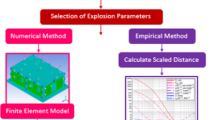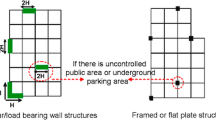Abstract
The smart cities comprise of low, medium and high rise buildings usually RC (Reinforced Concrete) framed structures having masonry in-filled wall panels both at exterior and interior faces. Any damage caused due to blast/bombing to such structures may cause larger damage to life in vicinity of the event area. Keeping view to this aspect the present endeavour has examined the effect of air blast on masonry in-filled RC framed wall acting from various angle of detonation (0°, 30°, 45°, 60°, and 90°). The deliberation will discuss the findings entertained.
Access provided by Autonomous University of Puebla. Download conference paper PDF
Similar content being viewed by others
Keywords
1 Introduction
India in the past few years has suffered many bombing attacks which has not only resulted in the loss of life but, also has caused damage to property and infrastructure. Masonry is the most common type of construction found in India due to its low cost, durability and ease in maintenance. However, masonry is found to be quite weak when subjected to out of plane loading such as earthquake, blast, high and low-velocity impact. Therefore, it has become important for civil engineers to study the effect of such events (blast) on structures so that the ‘Smart Cities Mission’ of India can be smartly accomplished.
A bomb explosion near a structure may cause catastrophic damage like crumbling of walls, blowing out of windows, and sometimes even ceasing critical life safety structures. Keys and Clubley [1] investigated the breakage patterns and debris distribution of masonry panels subjected to blast loads. Three experimental trials were performed each on ten masonry panels of varying geometries. It was found that blast overpressure, structural geometry and impulse were the main parameters accountable for the initial fragmentation, breakage pattern and debris distribution, respectively. Yuan et al. [2] carried out distinctive finite element analysis of masonry infill walls for determining the blast properties using LS-DYNA. The reliability and efficiency of this method was proven to be satisfactory in predicting the dynamic and failure behaviour of masonry walls subjected to blast loads. Alsayed et al. [3] tested half-scale infill masonry walls against C-4 explosives. Both un-strengthened and externally strengthened (using GRFP) were subjected to the action of field blast. Later, the field test results of un-strengthened as well as the strengthened walls were compared and also simulated using ANSYS-AUTODYN. The numerical models were then further studied to see the effect of various parameters such as scaled distance and FRP end anchorage.
The paper has investigated the response of blast load on masonry in-filled RC (Reinforced Concrete) framed wall. The numerical model has been developed in ABAQUS/Explicit software and validated satisfactorily. Thereafter, the effect of the blast from various detonation angles on the numerical model has been studied.
2 Numerical Modelling
Masonry in-filled RC framed wall previously tested in field by Varma et al. [4] against various scaled distances has been taken for the numerical study. The experimental wall having thickness 230 mm has been modelled in Abaqus/explicit tool using macro modelling approach as shown in Fig. 2. Eight-noded SOLID 65 element has been used to model both masonry (3000 × 3000 × 230 mm) and concrete frame (230 × 235 mm) whereas, steel reinforcement has been modelled using 3D-TRUSS element. The non- linearity in material properties of masonry, concrete and steel has been considered using Mohr–Coulomb (MC), Concrete Damaged Plasticity (CDP) and elasto–plastic strain hardening criterions, respectively. The mechanical properties of model are tabulated in Table 1.
Mesh size of 100 mm has been used to discretise the model as shown in Fig. 2. The friction coefficient between the RC frame and masonry has been taken as 0.8 [5]. The base of the wall has been considered fixed as shown in Fig. 1. A total of 3490 elements were generated having 5358 nodes.
The developed model has been subjected to blast pressure-time history (Fig. 3) for TNT explosive at various scaled distance to determine the peak displacement at the center of wall. The results of numerical study have been compared with the experimental data in Table 2 and are found to be quite satisfactory thereby, validating the numerical model.
3 Parametric Study
The numerical model has further been considered to see the effect of air blast occurring at a different angle of detonation at a height of 1.5 m above the ground. The air blast load has been generated using the inbuilt ConWep (Conventional weapon) tool in Abaqus software. In ConWep the amount of charge (in kg of TNT) and stand-off distance (in metre) is specified. Then a Reference Point (RP) is selected in space (x, y, z) where the detonation will occur and a target area is indicated where the responses are to be investigated. Also, for the parametric study the top of the wall has been restrained in Z-direction (perpendicular to the plane of the blast surface) as in real conditions a slab will be there having high stiffness in the in-plane direction (Fig. 4).
3.1 Variation in Angle of Detonation
The numerical model has been subjected to air blast load of 100 kg TNT at stand-off distance 20 m and height 1.5 m above ground. The responses have been investigated to see the effect of variation in angle of detonation 0°, 30°, 45°, 60° and 90°, respectively. The displacement, stresses and pressure time histories obtained after the analysis are shown in Figs. 10, 11and 12. Also, the contour plots for various angles of detonation are shown in Figs. 5, 6, 7, 8 and 9.
4 Results and Discussion
The numerical model subjected to air blast load acting at various angles 0°, 30°, 45°, 60° and 90°, respectively have been studied. The peak values of displacement, stress and pressure developed at the mid/centre of the masonry panel are been tabulated in Table 3. It can be observed that the peak displacement is increasing as the angle of detonation is sweeping towards the front face of the wall. When the blast occurs at 0° (in-plane angle) and stand-off distance 20 m then the peak displacement is minimum compared to when the blast occurs at 90° (out of plane angle).
5 Conclusions
It can be concluded from the results that angle of detonation plays a significant role in the level of damage caused in masonry in-filled RC framed wall. The maximum deflection in-wall has been observed when blast acts at an angle 90° i.e., in out of plane direction. Therefore, this orientation may be considered as critical and can be opted for further research studies.
References
Keys RA, Clubley SK (2017) Experimental analysis of debris distribution of masonry panels subjected to long duration blast loading. Eng Struct 130(2017):229–241
Yuan X, Chen L, Wu J, Tang J (2012) Numerical simulation of masonry walls subjected to blast loads. Adv Mater Res 461:93–96
Alsayed SH, Elsanadedy HM, Al-Zaheri ZM, Salloum YA, Abbas H (2016) Blast response of GFRP-strengthened infill masonry walls. Constr Build Mater 115:438–451
Varma RK, Tomar CPS, Parkash S (1997) Damage to brick masonry panel walls under high explosive detonations. Press Vessels Pip Div 351:207–216
Pandey AK, Bisht RS (2014) Numerical modelling of infilled clay brick masonry under blast loading. Adv Struct Eng 17(4):2014
Author information
Authors and Affiliations
Editor information
Editors and Affiliations
Rights and permissions
Copyright information
© 2020 Springer Nature Singapore Pte Ltd.
About this paper
Cite this paper
Shamim, S., Ahmad, S., Khan, R.A. (2020). An Investigation on Response of Blast Load on Masonry Structure. In: Ahmed, S., Abbas, S., Zia, H. (eds) Smart Cities—Opportunities and Challenges. Lecture Notes in Civil Engineering, vol 58. Springer, Singapore. https://doi.org/10.1007/978-981-15-2545-2_44
Download citation
DOI: https://doi.org/10.1007/978-981-15-2545-2_44
Published:
Publisher Name: Springer, Singapore
Print ISBN: 978-981-15-2544-5
Online ISBN: 978-981-15-2545-2
eBook Packages: EngineeringEngineering (R0)
















